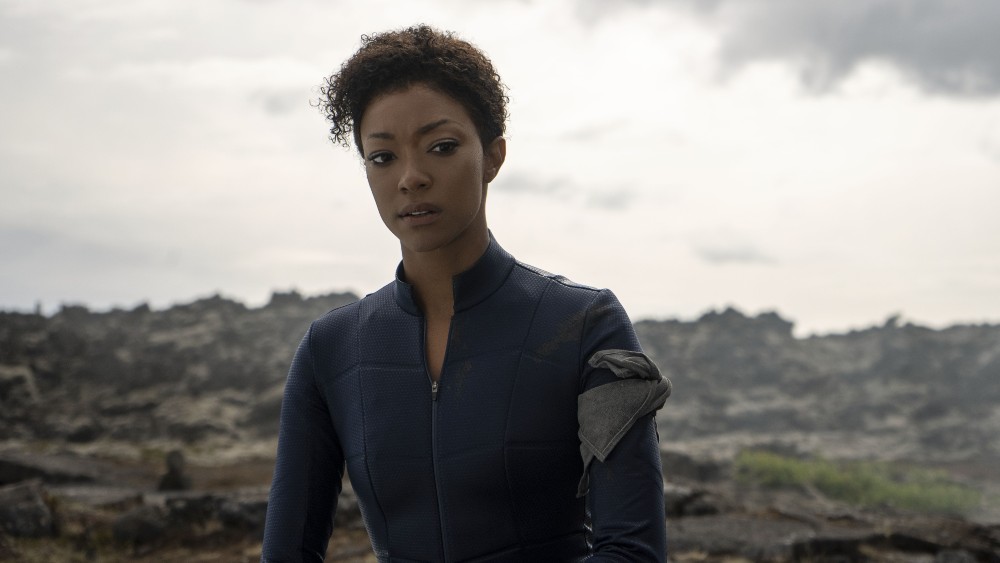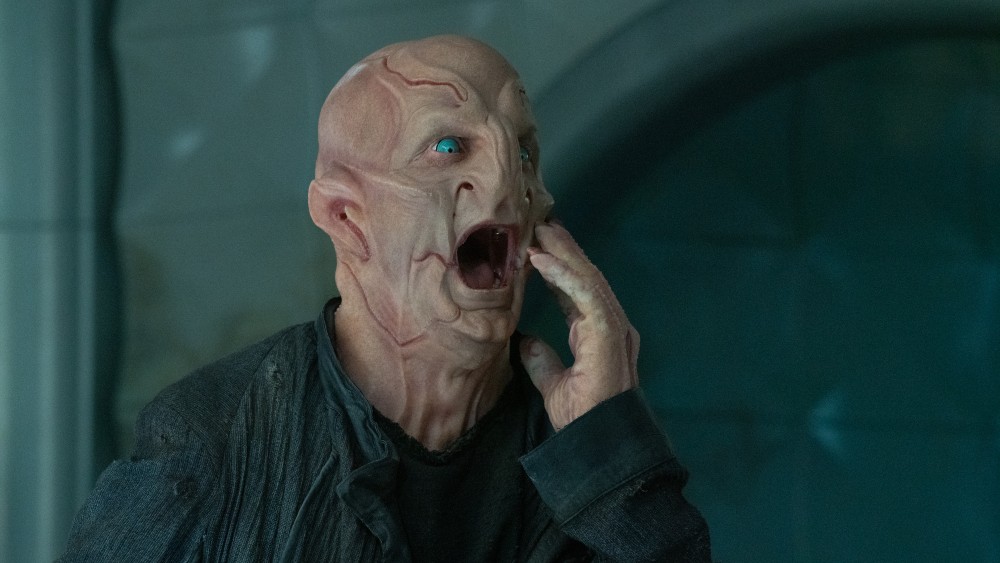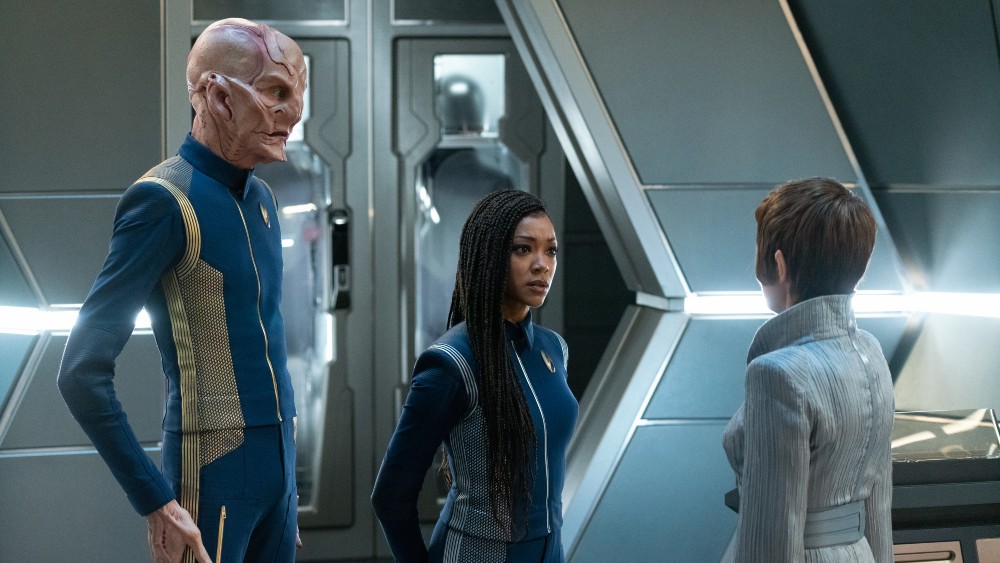
Over three seasons, the crew of the starship Discovery has traveled through galaxies and centuries, stopping wars, ending tyrannies, battling enemies from across more than one universe. In each encounter, they adhere to the principles laid out by Star Trek creator Gene Roddenberry.
As the third season starts, Michael Burnham (Sonequa Martin-Green) has been separated from her ship and flung through a wormhole hundreds of years into the future.
The Emmy-winning Star Trek: Discovery is the seventh series in the franchise, and the first since 2005. Jon Dudkowski edited the pilot episode, helping establish the tone and pacing for the series, and has worked on each subsequent season. He also directed an episode, Unification III.
He spoke with Below the Line by telephone from London, where he is working on his latest project.

Below the Line: What brought you to Star Trek: Discovery?
Jon Dudkowski: I’ve been a Star Trek fan my entire life. Literally, this has been my fantasy job. Four years ago I heard that David Semel was going to be directing the pilot, and I reached out to him.
The fun thing about doing a pilot is that it carves out the tonal voice of a series. As an editor, you really get to help describe what the show is going to be. Everyone who comes along afterwards is kind of working within that framework.
The first season had a very specific tone, and then [Creator and Executive Producer] Alex Kurtzman directed the first episode of season two, which was more adventurous. Each season has a massive change in the storyline. In season three there’s the wormhole, and something called the “big burn” which collapsed galactic society as we know it.
Below the Line: Several editors are credited this season.
Dudkowski: It’s a big show. This is not a hard and fast rule, but there are approximately three editors. If I cut episode one, then Scott Gamzon may do two, and Andrew Coutts three, I would do four, and so on. We’re all working to the vision of Alex Kurtzman and [Executive Producer] Michelle Paradise.
Below the Line: What’s your work flow?
Dudkowski: The basic framework is very similar to any kind of episodic television. We have between 10 to 12 days of shooting. Whatever they shoot on Monday, I’ll get on Tuesday, and I’ll assemble it. At the end of the shoot, my assistant and I have a few days to build our version of the show. Then we’ll work with the director for four days on his version. After that, we’re with the producers.
Star Trek is different from average television because the world is completely fabricated. There’s no real world, so sound design and VFS are enormously important. Having a really strong and intimate understanding of how the visual effects are going to work is crucial, because a lot of times we’ll get scenes that are just an actor standing on a green screen stage. You have to understand by looking at the original concept art and storyboards, and talking with the directors, then looking at the footage, to get a feel for what the actual film will support.
In terms of the work flow, one of the things that makes Star Trek different is the tail. We’ll finish an episode and the visual effects team will need months to get all the effects together.
Below the Line: There are some constants in every Star Trek iteration, like characters walking down corridors discussing the plot. Or complex dialogue scenes on the bridge.
Dudkowski: Putting a bridge scene together is one of my favorite things to do, because I can play with the shape of a scene, the tone of it, the drama of it, the looks between the characters on the bridge. Because the green screen in front of the characters hasn’t been designed yet, the editor has a lot of creative opportunity to refine the story, change the way a scene is shaped.
With the hallway walk-and-talks, I’m constantly struggling with continuity. You don’t have many places to go, there are fewer cutaway opportunities. You definitely want to get a shot behind your actors as they’re walking, so you can add ADR. The last thing you want to do is get stuck with a oner walk-and-talk, because then you’re really locked in.
Below the Line: How do you cut the fight scenes? Do you get involved with shot-planning and choreography?
Dudkowski: It depends on the episode. One of the things I find is that every fight has a point of view. There’s always somebody you’re rooting for. I’ll find the most poignant, interesting moments in the footage and string those together, then figure out what I need to make the other pieces work. I’ll carve off of that to give it some shape. Maybe it needs to be faster or slower. With good choreography, you’re usually covered on both sides. So in editing, it’s important to figure out the point of view, and then revise the fight to work to that end.

Below the Line: You also have to balance so many storylines.
Dudkowski: There’s a scene in the virtual world with Su’Kal [Bill Irwin] where he’s coming out of a virtual experience, but he’s reliving moments of his childhood as a flashback that a computer is helping him see. Keeping track of all of those elements — what was real, what wasn’t, where we were as the viewer in terms of reality — was really complicated. It was multi-layered, a flashback of a virtual experience as opposed to a flashback of reality. It was a good challenge.
Below the Line: What’s the best way to get in and out of flashbacks?
Dudkowski: I teach editing, and this point comes up a lot because a lot of student films involve flashbacks. The single best device for keeping a clear transition from a flashback is actually sound design. You can do things with picture, with the image, but if the sound design is handled correctly, it’s very clear where a flashback begins and ends.
Below the Line: Getting back to narrative balance, in the last episode you are juggling separate storylines where everything’s going to blow up at any minute. Cutting among those must be tough.
Dudkowski: It would have been very easy to just stick with one story and then hop over and tell another, but then they wouldn’t interweave the way they did in the writing. We moved scenes around, and we did a lot of experimentation. Where can we take a piece of this scene? Can we cut the scene in half, part here and part there? The hardest thing was we had an action storyline of the fight aboard Discovery, and a space battle going on outside. Then we had people trapped in a virtual nightmare. So two of the stories were very active, and one of them very cerebral. To cut from action to cerebral was very tricky. You didn’t want the audience to feel like they were being in a car that kept going from first gear to fourth gear and back.
Below the Line: Are you ever surprised by the VFX?
Dudkowski: One of the things that I like about editing Star Trek is that the visual effects do evolve. They’re not set in stone. For example, there is a sequence when Adira [Blu del Barrio] goes into the pools and remembers her lover Gray [Ian Alexander]. The visual effects of how she remembered Gray evolved a lot in the edit. We realized that it was a lot more interesting if the visions were more opaque and not nearly as clearly defined as they were originally intended. As the editor, you have a lot of voice in how that story got told.
Below the Line: How do you cut between two moving shots?
Dudkowski: We do a lot of little minute speed changes if need be. One of the things that comes with editing for years and years is having an intuitive rhythm. Sitting alone in a dark room with deadline pressure for a couple of decades has helped give me that intuition. There are also little tricks. Even if the camera’s moving in one and moving in the other, as long as there’s some motivating action — in a character’s movement, or in a look — you can make a seamless edit. Even a sound, especially with Star Trek, because there’s such a rich sound background. If I can’t find any other way to motivate an edit, you’ll hear a door open or close in the background and it will be just enough to bridge that moment.

Below the Line: You directed one of the episodes, Unification III.
Dudkowski: Yes, my first time. I’ve always dreamed of directing, but I also really enjoy editing. When I had my family, I kind of backed away from [my] directing career, since it’s a tough, tough racket, honestly. But with Star Trek, I convinced them to give me a shot last season. I’m hoping more will come, but for now, I’m kind of straddling the fence between editing and directing.
Below the Line: This is you last season with Star Trek: Discovery?
Dudkowski: Yes, I’m working with Alex Kurtzman on The Man Who Fell to Earth for Showtime. I wouldn’t have left Star Trek for anything less than a unique opportunity. Star Trek is one of the very few non-dystopian visions of the future. It’s this inclusive, progressive vision of the future. I am so profoundly proud to be a part of it. The stories and characters are interesting, and I love all the devices the show has. But more than anything, I am so proud of being a part of a franchise that shows a future that is positive and hopeful. I’ve got two kids, and I want them to look forward to the future. I want them to be excited about science and math and inclusivity. Star Trek does all of that.
All three seasons of Star Trek: Discovery are available on Paramount+.





